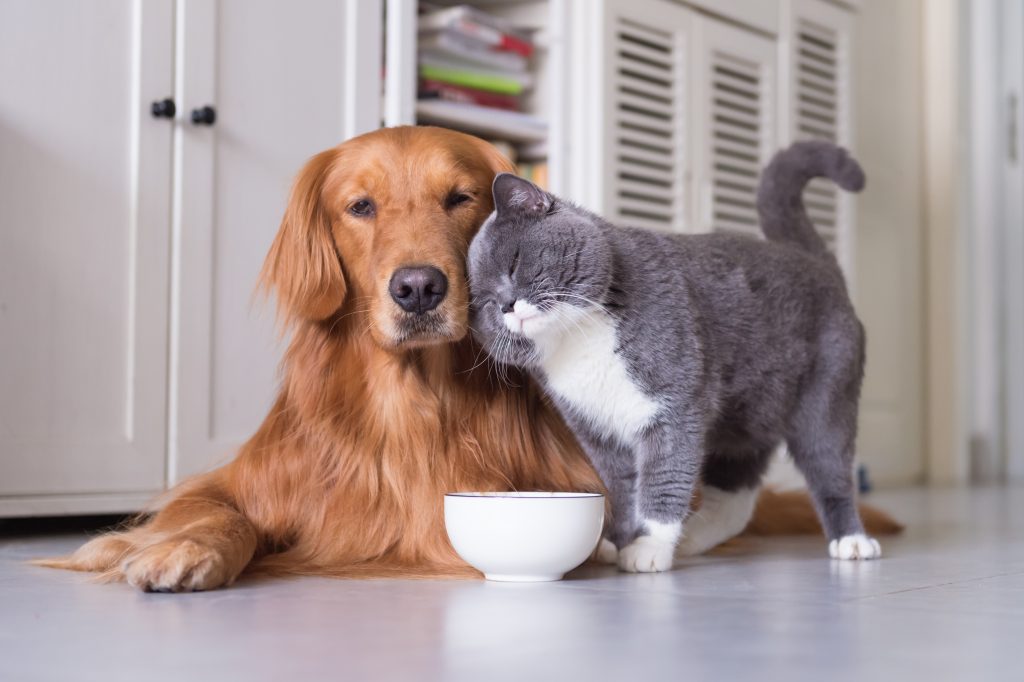Choosing how to feed our pets can be a difficult decision to make. We want to choose the food that is best for them, since we will be feeding it to them every day for every meal. But what if we choose to not choose? A new philosophy of feeding pets is here – combination feeding.
What is it? Feeding a variety; including a multitude of ingredients and types of food as well as different nutrient balances.
How is it different? The most common way to feed pets is to feed one food, or a few formulas from the same brand. Most pet owners also only feed one type of food (kibble only/raw only) or maybe two (kibble and cans).
What is it beneficial for? Weight management, digestive health, preventing sensitivities, hydration, overall health, budget.
Weight management:
The benefit for weight management comes down to metabolic flexibility. By feeding a variety of foods with different nutrient balances, digestive and metabolic processes need to be very active and very adaptable, allowing the body to switch between different fuel sources (protein, fat, carbs) efficiently, resulting in less energy deposition (fat deposition). It is still important not to over-feed. Total calories should not exceed maintenance requirements and daily calorie intake should not differ when feeding different foods. Feed to the ideal body condition and pay close attention to any changes in body condition or muscle condition.
Digestive health:
As previously mentioned, varying the nutrient balance of meals results in active and flexible digestive processes (enzyme activity). This not only ensures pets get the most out of their food by absorbing as many nutrients as possible, it also limits the amount of undigested nutrients that end up in the large intestine. Undigested fat, protein and starch is detrimental to the microbial population in the gut. Feeding different formulas also provides a variable balance of fibre. there are many species of beneficial microorganisms in the gut, the balance of which is unknown. It is beneficial to provide a variety of prebiotic fibre sources to ensure all beneficial bacteria are supported.
Preventing sensitivities:
Adverse food reactions could be related to over-exposure to certain proteins along with damage to the gut. Feeding the same protein source every single day means the body is exposed to that same protein every day. Some damage to the gut lining is inevitable, whether it be from infection, environmental irritants or poor-quality food. Damaged areas of the gut lining can allow large particles of undigested nutrients to pass through when they are not supposed to, eventually leading to a reaction from the immune system. The first benefit to combination feeding is limiting gut damage. By including raw or raw alternative foods, we decrease the amount of processed food we are feeding. On top of this, we are not constantly feeding the same exact ingredients, and this limits the chance of over-exposure to the immune system.
Hydration:
The average dog must consume approximately 1oz of water per lb of body weight to remain hydrated, and the average cat requires about 0.8 oz of water per lb of body weight. These requirements increase in warmer temperatures or with higher activity. If animals are consuming a primarily dry diet, it is very easy for them to become dehydrated by not drinking enough. Hydration is essential for every process in the body. Incorporating moist foods into the diet is an easy way to hydrate pets. Canned food, rehydrated freeze dried/dehydrated, wet toppers or raw food are all very hydrating and palatable.
Overall health:
There are so many ingredients used in pet foods and many philosophies surrounding the feeding of pets. Grain free, grain friendly, novel proteins, raw diets, low carb … it seems impossible to navigate; how do we know which foods to choose and philosophies to follow? The great thing is that we do not have to choose just one. Every ingredient has nutritional value and every type of food has benefits. We can offer our pets the benefits of everything by feeding many different formulas. Sometimes, ingredients have potential downsides for certain pets. It may not be clear which ingredients are not tolerated as well by our pets until much later in life. We may only see a negative impact when an ingredient is fed every day for many years and by feeding a variety of ingredients, any potential negative effects would be diluted immensely.
Budget:
We all want to purchase the absolute best food for our pets that we can afford. Sometimes though, our budget changes. Unexpected expenses come up, holidays strain the budget, lifestyles change. When budgets change and a less expensive formula is needed, or maybe there is more money available to be spent, it is much easier to transition diets when our pets are already flexible.
Combination feeding allows us to see which types of diets our pets do best on so we can more specifically tailor their feeding plan for their individual needs. It also allows them to obtain the benefits of different types of foods and ingredients and offers them a variety of flavours to enjoy.
There are many ways to start combination feeding. Different formulas can be rotated on a monthly, weekly or daily basis, different types of food can be mixed together in various combinations, or more simply, nutritious food toppers can be added to your pet’s current diet.
Visit your local Global Pet Foods store and speak to the educated staff about how to start introducing combination feeding to your pet.












